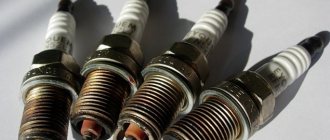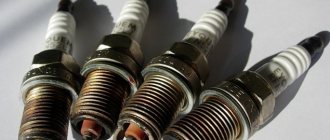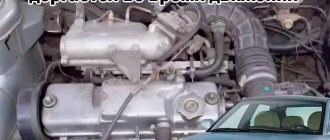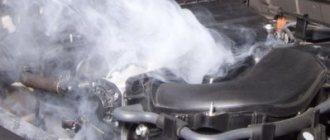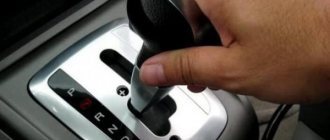Modern cars have a large amount of electronics; even fuel intake and mixture adjustment are determined by a computer using various sensors involved in the engine operation. In order for the engine to run smoothly and without interruptions, it is necessary that all its components are in good condition, because even the failure of one seemingly small sensor can lead to big problems.
This article will discuss the reasons why a car starts to jerk under certain conditions. Whether it's low revs, load, acceleration or high revs.
Why does the engine jerk at low and idle speeds?
So, if the car jerks at idle, there may be several reasons for such a malfunction. Most often, problems affect the ignition system and power supply system; less often, elements of the engine control system or parts inside the internal combustion engine fail.
- First of all, damage to the engine mounts should be excluded, since increased vibrations from the internal combustion engine in this case often occur precisely at idle. If everything is normal with the airbags, then twitching of the power unit may occur due to malfunctions of one cylinder.
- The most common cause is spark plugs, as well as high-voltage armored wires. Often, the spark plug may be damaged, dirty from carbon deposits, etc., as a result of which there is a spark on it, but it is very weak or unstable, and is supplied at the wrong angle.
Damage to the insulation of high-voltage wires when a spark “breaks through” also leads to similar symptoms in the form of motor twitching. The ignition coil, switch, ignition module, and distributor also deserve additional attention. Depending on which ignition system is installed on a particular engine, all its elements must be checked one by one.
- After diagnosing the ignition system, you need to move on to the fuel and air supply systems. As a rule, injection nozzles may be faulty or dirty. Fuel filters are also checked, and fuel lines should be inspected for leaks.
- Let us also add that in cases where the engine jerks at idle, you need to make sure that not only the fuel filter, but also the air filter is in good condition.
The fact is that if the air filter is dirty, the engine may not have enough oxygen to prepare the correct fuel-air mixture. The same is true in cases where airing occurs in the power system or excess air is sucked in at the inlet.
In any case, the mixture may turn out to be too rich or lean, and the normal and timely combustion of such a charge in the cylinder does not occur. At the same time, in such a situation, the spark plugs become even more covered with soot, and sparking further deteriorates.
- On injection engines, the cause of twitching at idle in some cases is the electronic engine control system (ECM). In such a situation, it should be taken into account that this system includes a whole group of various electronic sensors and actuators that exchange data with the controller (ECU).
- Another possible cause of engine jerking at idle is problems with the throttle valve and problems with the IAC (idle air control). The idle air control itself is a stepper motor that closes the channel for supplying air bypassing the throttle valve.
In case of incorrect operation and malfunction of the regulator, as well as in the accumulation of a large amount of dirt and carbon deposits on the damper, the idle speed becomes unstable. In this case, the engine not only jerks, but the idle speed often fluctuates greatly.
Such “floating” of revolutions can appear on a cold engine and disappear as it warms up. Also, in some cases, the speed jumps and floats both cold and hot. To solve the problem, you need to clean the throttle and also check the IAC. It is also important to consider that on many cars, after cleaning, it is also necessary to train the throttle valve.
Why the engine jerks during acceleration: the main reasons
Let's start with the fact that most of the reasons why such deviations occur in the operation of internal combustion engines are often associated with the following systems:
- engine power system;
- internal combustion engine ignition system;
The culprit may be either the carburetor itself (dirty jets, incorrect settings, etc.) or the fuel pump. At the same time, we should not exclude the possibility that excess air is being sucked in somewhere, which causes the carburetor engine to jerk when accelerating the car.
As for modern injection engines, a number of common problems will be similar to engines with a carburetor. At the same time, problems that are unique to units with injection injection are also added to the list. Let's focus on the possible causes of dips and jerks.
- First of all, let's start with the ignition system. As a rule, if problems arise in this system, there is a loss of power and the unit consumes more fuel. Usually spark plugs, high-voltage armored wires, and ignition coils fail. We also note that on injection cars the problem may lie in a faulty camshaft position sensor (CPR).
What causes the car to jerk when running at low speeds?
Since the car begins to twitch when reaching even low speeds, it will not be possible to immediately identify one specific problem. Problems may be hidden:
- In the engine fuel mixture supply system;
- In the vehicle ignition system;
- At the checkpoint;
- In the distributor design;
- Includes fuel filters;
- In the sparking system;
- In the control unit of the vehicle's on-board computer.
Let's go through the faults in each of the listed systems in detail.
Tip: When detecting a “jerking” behavior in the vehicle, the brakes may also squeak when braking. These 2 problems can be either interrelated or indicate completely different breakdowns.
Checking the engine fuel mixture supply system
Often the reason that the car jerks at low speeds is due to a malfunction of the power system. When the car starts to move, the cylinders simply cannot receive the required amount of fuel mixture, as a result of which the car is unable to transfer the required amount of power to the chassis for smooth driving and smooth commissioning of the transmission. As a result of increased pressure and transmission resistance, uneven running of the machine appears.
To solve this problem, it is recommended that you first pay attention to checking the throttle body. It also wouldn’t hurt to test and diagnose the performance of the sensors installed in the system for determining idle speed indicators. Do not forget to check the serviceability of the throttle valve position and the mass air flow sensor.
Throttle body
During diagnostics, most often a breakdown is found in the injectors responsible for uniform injection of the fuel mixture. In rare cases, engine jerking problems may be related to the air ducts that connect the injector receiver to the air filter structure. Here the problem lies in depressurization of connections and loss of pressure.
The solution to the problem is to replace all faulty components yourself or with the help of car service specialists. After repair, it is recommended to ensure that all connections are in good working order and that there is no loss of pressure in the fuel line system that is connected to the fuel pump itself.
If a power unit with a carburetor system was installed in the engine compartment of your vehicle, then you need to check the idle valve and the absence of damage directly to the carburetor.
Checking the car's ignition system
Sometimes the car starts to jerk while driving at low speeds as a result of a breakdown in the ignition system. Basically, the problem will be caused due to untimely ignition of the fuel mixture and air flow. In rare cases, the malfunction may be hidden in the receipt of low voltage from the spark plugs. The spark voltage simply will not be enough to ignite the fuel mixture in a timely manner. Also, when diagnosing the ignition system, check:
- Performance of ignition coils;
- Serviceability of the spark plug set;
- No tears in high-voltage wires;
- There are no problems in the ignition distributor-interruptor (in simple terms - in the distributor);
- Correctness of values coming from a set of sensors responsible for the position of the camshaft and crankshaft;
- The performance of the switch located inside the entire structure.
The appearance of jerking in the car when you sharply press the gas
If the cause is not related to the fuel pump, then these symptoms may indicate the so-called “triple” of the engine. A situation arises in a car in which out of 4 cylinders only one can work correctly. As a result of the “triple”, the engine simply cannot respond in time to pressing the gas pedal, after which similar problems arise. You can deal with the breakdown in the following ways:
- If the oxygen supply sensor is not working properly, the system is diagnosed using a multimeter. If any faults are found, it is simply replaced.
- If the valve timing in the engine is shifted, it is necessary, with the help of car service specialists, to adjust them according to the appropriate instructions.
- Detection of an incorrect glow number of spark plugs is resolved by installing a new set with the correct number.
- The problem of clogged injectors can only be solved at a car service center. To do this, they are installed on a special stand, which simulates the operation of a motor, and washed with a special solvent.
- The problem can also arise if the emulsion tube and well located in the design of the second chamber of the carburetor engine are clogged. The only solution here is to flush the carburetor and pipe with kerosene.
Why does the car jerk while driving?
The situation when a car starts to move unevenly is familiar to every motorist. The problem, which manifests itself in jerking and jerking, can be caused by the incorrect operation of various automotive systems. Today we will look at the common symptoms of this “disease” and share recommendations for eliminating them.
So, a violation of the smoothness of the ride and the associated jerks of the car occur:
- when starting off;
- during acceleration;
- at low speeds;
- when the engine is operating at maximum load;
- in transient conditions;
- in all of the above cases.
Determining the culprit of the malfunction
The car can “twitch” while driving for various reasons, so you should adhere to a certain troubleshooting algorithm. If there are no obvious signs of transmission malfunction, then first of all we check the power and ignition system.
Failures in the engine power system
Malfunctions in the system for preparing and supplying the fuel mixture are indicated by jerking of the machine in motion. In this case, the malfunction can manifest itself in different ways:
- The car begins to twitch when the accelerator pedal is pressed sharply. At the same time, instead of gaining speed, the engine runs jerkily, and therefore the car picks up speed very reluctantly. At some stage, the twitching stops and the engine “picks up.” In other cases, the power unit stalls when the throttle is maximally open, or jerking occurs when the gas is released.
- The unevenness of the ride appears unexpectedly - when the car is moving at a constant speed, in a stable speed mode.
As you can see, uneven engine operation can appear both when the crankshaft speed changes sharply or smoothly in one direction or another, or when operating at stable speeds. The reason for these phenomena is a simple lack of combustible mixture, due to which the engine simply cannot develop power sufficient to overcome the resistance of the transmission.
To eliminate negative phenomena, we check several main components of the power system:
1. Filter. Even with a working fuel pump and a clean fuel line, the engine will begin to starve if the fuel filter is clogged with dirt. The way out is to replace or clean the filter element - it all depends on where exactly the blockage occurred. The fact is that car engines have several cleaning elements installed along the fuel path. If you are dealing with an injection internal combustion engine, then you should pay attention to the third filter element located after the fuel pump. Designed to separate the smallest particles, it clogs quite often, which is why the gas pump cannot pump the required volume of fuel through it. For carburetor cars, we check both the third filter installed in front of the carburetor, and the second one - it is located between the fuel tank and the fuel pump. If replacing them did not yield anything, then you should check the coarse filter installed on the fuel receiver. In addition, the cause of insufficient fuel supply may be the mesh located in front of the float chamber in the carburetor body.
2. Throttle assembly . Malfunctions in the throttle can be caused by wear and damage to its parts and contamination. And if the first requires serious repairs, then in the second case, simple cleaning of the throttle assembly elements mechanically will help. In the case of carburetor internal combustion engines, the situation is more complicated, because you will have to completely disassemble the carburetor and clean all channels, jets, diffusers, etc.
3. Fuel pump. To troubleshoot the fuel pump, remove the cap, then inspect the diaphragm and valve hole. In most cases, the jerking of the car when driving, associated with a decrease in fuel supply due to the fuel pump, occurs due to the o-ring - it may be located somewhere near the valve or may be completely absent. To restore the pump's functionality, replace the damaged diaphragm and the problematic valve, and then restore the tightness of the system. In addition, it is recommended to clean the mesh, which is located directly in the fuel pump housing. As for injection engines, their fuel pumps are electrically driven and located in the tank. Therefore, check if there are any losses in the fuel line itself.
What's the result?
As you can see, the engine can jerk during acceleration for a number of reasons. If replacing “consumables” (spark plugs, armored wires, filters), as well as standard scheduled procedures (cleaning the injector, adjusting the carburetor, setting the OZ, etc.) do not produce results, then you should also check the timing belt or chain, that is, the installation valve timing.
In such a situation, urgent diagnosis of the gearbox is necessary. It is easier to deal with a manual transmission by replacing the clutch disc, pressure plate or the entire assembly. On vehicles with a classic torque converter automatic transmission or manual transmission (robotic gearbox), if jerking occurs, you must stop using the vehicle.
Then you need to check the oil level in the automatic transmission and its condition. Next, diagnostics of electronic components, actuators, etc. will be required. You also need to be prepared for the fact that the gearbox (as a rule, this applies to automatic transmissions) in many cases will need to be disassembled for troubleshooting and subsequent expensive repairs.
As a result, jerks and dips appear when accelerating, and the car jerks in motion during transitional conditions. Causes and troubleshooting.
Purpose, design features, installation location of the fuel pressure regulator of an injection engine. Signs of RTD malfunctions, checking the device.
What to do if the car accelerates worse, does not pick up speed, or has failures during acceleration. Why the engine does not pull, how to find the reason for the decrease in power.
Why the engine may not pick up speed: gasoline engine, diesel unit, car with LPG. Fault diagnosis, useful tips.
The most common reasons why an engine does not develop full power. Why do they occur? Common problems with gasoline and diesel engines.
Signs of a non-working cylinder (tribbing and vibration) of a diesel engine. Troubleshooting: compression, diesel injectors, glow plugs, injection pump and others.
Electric gas pedal
A common reason when the car jerks is the failure of the electronic gas pedal. Modern cars have an electronic gas pedal. It works on the principle of a potentiometer and has a structure similar to it. Like any potentiometer, it has tracks along which the sensor runs. This sensor is mechanically connected to the pedal.
Although the gas pedal housing is hermetically sealed, it sometimes happens that moisture gets into it, and as you know, electronics do not like moisture. Since the tracks are made of metal, they begin to corrode. This reduces contact with the sensor. The pedal starts to work incorrectly and the car jerks when you press it. Dips are felt both at idle and while driving.
GAZ 3302, engine 405, 2005, when accelerating, when you press on the gas, it jerks, replacing high-voltage wires and spark plugs did not give any results, what could be the problem?
what is needed for diagnosis?
How to understand. For diagnosis you need to go to a diagnostician. How can I say it more clearly?
Gazelle twitches when moving engine 402
Good afternoon. The topic of today's article is the problem of the ZMZ 402 engine; the article provides a step-by-step algorithm for troubleshooting with video.
The ZMZ 402 engine was developed a very long time ago; it is still widely used in UAZ, GAZelle, and Volga vehicles.
Step 1 - Finding a Bad Cylinder
The troubleshooting algorithm is very simple - warm up the engine to operating temperature and, at idle, remove the wires from the spark plugs one by one, as in this video:
If the engine speed decreases, you have removed the wire from the slave cylinder, if the engine performance does not change, the cylinder is not working. ZMZ 402 remains operational on 2 cylinders!
When the engine fails, there are only two reasons - there is nothing to burn in the idle cylinder, or there is nothing to set it on fire, hence the further troubleshooting algorithm.
Step 2 - check the ignition
The spark on the spark plug ignites the combustible mixture. We consistently check the spark on the wire (just keep it 3-5 mm from the engine)
If the spark does not jump, the cause of the tripping is found to be high-voltage wires or the distributor cover.
If the spark jumps, remove the spark plug.
If it is wet and smells of gasoline, the spark plug is most likely faulty, but it can only be checked in a special pressure chamber. Personally, I have never seen this camera, and I always checked the spark plugs with a banal replacement, fortunately the price of a set of A14 spark plugs does not exceed 200 rubles.
If after replacing the spark plug the engine runs smoother, it makes sense to replace the remaining spark plugs (they usually fail at the same time).
This indicates an air leak.
Step 3 - looking for air leaks
The easiest way to find air leaks is to use a cigarette, bring it to the intake manifold and observe the smoke (the mechanical cooling fan can be unscrewed during the test, but no more than 3 minutes of operation without it is permissible). If cigarette smoke does not show air leaks, try clamping the VUT hose:
If the engine runs smoother when you pinch the hose, the problem is either in the hose or in the brake booster.
Favorite places for air leaks on the 402 engine:
- Cracked VUT (vacuum brake booster) hose
- Gasket failure under the intake manifold
- VUT membrane failure
Once I encountered an engine tripping due to deformation of the carburetor frame, but there the engine was more likely to double!
If everything is done consistently, then there will be no difficulties in identifying the malfunction due to which the ZMZ 402 is tripping.
If you have anything to add to the article or have any questions, please write comments.
A lot of worries, nerves, and sleepless nights are caused to car owners by the situation when the carburetor of their car begins to emit loud pops, similar to gunshots. At the same time, the car jerks, sneezes, and the engine runs unsteadily. This article explains why this happens and how to eliminate it. So, why does the carburetor shoot?
The main reasons for shots in the carburetor
When operating their vehicles, in practice, many car drivers quite often encounter the fact that the car shoots into the carburetor. Loud popping noises can be heard either when starting the engine, or when the engine is already warm when driving on the freeway.
Most experts who are well versed in carburetors express a competent opinion that such phenomena are caused by:
- excessively lean fuel-air mixture;
- the ignition is not set according to the instructions;
- malfunctions of the gas distribution mechanism;
- malfunction of the distributor-breaker (distributor);
- The operating phases of the gas distribution mechanism are not adjusted.
Considering that all carburetors in the vast expanse of the CIS are manufactured by enterprises of the Russian Federation, the article will consider the work and pops in the carburetor of VAZ cars, as well as why the 402nd engine of the Gazelle car, known to all motorists, shoots into the carburetor.
What does shooting into the carburetor entail?
Experienced car owners know that if the carburetor shoots when you sharply press the gas, this phenomenon always entails a large set of various unpleasant surprises:
- increased gasoline consumption;
- the running motor overheats greatly;
- the power unit does not develop full power;
- idle speed is unstable;
- the engine shoots into the carburetor, it is difficult to start.
Source: https://mastershuma.ru/gazel-dergaetsja-pri-dvizhenii-dvigatel-402/
Categories Engine
The problem is not with HBO
Quite often it happens that the car jerks on the gas while driving not at all because of the gas equipment, as the driver thinks, but because of a malfunction in the electrical part of the car.
Most often, drivers identify the following problems:
- The gap in the spark plugs and their overall serviceability. It is believed that the optimal gap should be in the range of 0.7-0.9 cm, although some car enthusiasts set the gap on the spark plugs up to a value of 1.1. There are also special spark plugs for running cars on gas; they differ from regular spark plugs in their clearances and design. When a spark plug is faulty, it simply “breaks through”, as a result of which the current follows the path of least resistance.
- High voltage wires. The second most common problem is the wear and tear of the car's high-voltage wires. If your armored wires have traveled more than 80,000 km. without replacement, it is best to replace them with new ones. An experienced electrician will help identify the malfunction of one wire.
- The third most important problem is the problem with the car’s ignition coil; if there is a problem with it, the coil should be replaced with a new one.
- Gas mixture. The quality of the mixture can also have a serious impact on the car's behavior. Try changing the gas station to another.
A car with a carburetor engine jerks at low speeds
Cars with a carburetor undergo the same checks as injection cars, with the exception of electronics. Standard check of spark plugs, high-voltage wires, pipes and hoses. If all tested systems are functioning normally, the car will continue to twitch, then in all likelihood the cause is in the carburetor itself.
In this case, it requires reconfiguration and cleaning. The unit is dismantled, disassembled, and cleaned. Then all parts are washed with clean gasoline, the inserts and internal passages are purged with a compressor. After this, the carburetor is assembled and installed in place.
Drivers who care about the condition of their car, noticing the slightest malfunction, immediately take action. Even the simplest fault, like carbon deposits on spark plugs, can lead to serious problems. A faulty spark plug leads to a breakdown of the armor wire, then the ignition coil fails.
Likewise, dirty filters prevent the normal formation of a combustible mixture. The list of malfunctions can occur in any vehicle system. Undoubtedly, only careful attention to the operation of the power unit and timely diagnosis will protect against major problems. If the machine starts to twitch when operating in different modes, this is the first call for testing.
When accelerating the car, the engine jerks: how to find the cause of the problem
Quite often, when operating an injection or carburetor car, you may encounter that the engine jerks during acceleration. In other words, after sharply pressing the gas pedal, there is no clear response from the power unit, a pause-failure occurs, the speed increases in jerks, etc.
These jerks are a rapid change in the crankshaft speed, regardless of the position of the gas pedal and the degree of pressure on the accelerator. As a rule, such jerks follow in series, causing the engine to jerk.
As for failure, that is, when the engine “stubs” during acceleration, there is a noticeable delay in the reactions of the internal combustion engine after the driver sharply presses the gas to increase the speed. Moreover, in both cases, when you smoothly press the gas pedal, the speed increases without jerks or delays, that is, quite predictably.
It is quite obvious that operating a vehicle with such faults is not only difficult, but also dangerous. While driving, there is no opportunity to overtake, quickly change lanes, etc. To solve the problem, the engine requires in-depth diagnostics, since it is first necessary to clearly determine the cause of the breakdown.
Next, we will talk about why an injection engine or carburetor engine jerks during acceleration, as well as what methods can be used to identify and fix problems that have arisen.
Why the engine jerks during acceleration: the main reasons
Let's start with the fact that most of the reasons why such deviations occur in the operation of internal combustion engines are often associated with the following systems:
- engine power system;
- internal combustion engine ignition system;
On a car with an outdated power system in the form of a carburetor, you should highlight the inconsistent flow of gasoline into the float chamber. In other words, there is a shortage of fuel during intense acceleration.
The culprit may be either the carburetor itself (dirty jets, incorrect settings, etc.) or the fuel pump. At the same time, we should not exclude the possibility that excess air is being sucked in somewhere, which causes the carburetor engine to jerk when accelerating the car.
As for modern injection engines, a number of common problems will be similar to engines with a carburetor. At the same time, problems that are unique to units with injection injection are also added to the list. Let's focus on the possible causes of dips and jerks.
To carry out diagnostics, you will need to turn off the ignition. Next, the fastenings of the high-voltage wires to the coil and spark plugs are checked. If the inspection reveals no defects, then the engine must be started. If the spark is noticeable or a cracking sound is heard, this means that an electrical spark is striking somewhere.
If no breakdown is detected, you should unscrew the spark plugs and inspect them. The electrodes must be intact, excessive carbon deposits are not allowed, the insulator must not have cracks, etc. Checks may also require armored wires. In some cases, after replacing the spark plugs and spark plug wires, the engine stops jerking during intense acceleration.
However, it happens that these methods do not bring the desired result. In such a case, it is necessary to check the camshaft position sensor separately.
Let us also add that the ignition timing (ignition timing, ignition timing) also deserves special attention. If the car jerks when accelerating, the ignition may be too early. On carburetor internal combustion engines, it is necessary to manually set the specified angle. On the injection unit, adjustment occurs automatically. However, we should not forget that interference with the factory firmware of the ECU (especially on cars with gas equipment) or problems with sensors can lead to malfunctions of the ignition system.
To quickly check the ignition timing, you need to accelerate the car to a speed of about 50 km/h. After this, a higher gear is engaged (for example, 4th), and then you will need to sharply press the gas pedal. Detonation will immediately appear in the engine, which should not last more than a couple of seconds with a normally adjusted OZ.
- Now let's move on to the power system. At the very beginning, you should make sure that the fuel tank is filled with fuel suitable for the vehicle and meeting quality standards. Very often jerks and failures occur when low quality fuel was filled. In some cases, a “check” may also light up on the dashboard of fuel-injected cars.
If everything is fine with the fuel, then you need to check the fuel filters. If the filter is clogged, then the engine simply will not have enough fuel for a sharp increase in speed, while problems may not arise during a smooth press on the gas.
Another element to check is the air filter. Its contamination will also lead to the fact that the unit will not receive enough air, which is necessary to prepare the fuel-air mixture.
If the filters are clean or new, but the jerks are repeated, then you need to move on to checking the injector. The first step is to diagnose the injection nozzles. Contamination of the injectors leads to the fact that the engine is not supplied with fuel, which is needed in afterburner mode in full.
To solve this problem, the nozzles are removed, then their performance, spray quality (flash shape), timely response to opening and closing, etc. are checked. The next step is to measure the fuel pressure in the fuel rail.
If the pressure is low, then the cause may be the fuel pressure regulator, a problem with the fuel line, or the fuel pump. As for the fuel pump, which is located in the tank, the device has its own separate mesh filter, which also becomes dirty over time.
As a result, the pump is not able to pump hotter into the ramp and maintain the required pressure with a sharply increasing load on the internal combustion engine. This reason is the most common in relation to jerks and dips when pressing the gas sharply. To solve this problem, it is necessary to remove the fuel pump, and also clean or replace the fuel pump strainer.
Air leaks and sensors
As you know, the injection engine is equipped with an electronic engine control system (ECM), which completely controls the operation of the power unit. This system is actually multiple sensors and a controller (ECU). Based on sensor readings, the control unit adjusts the SOP, increases or decreases the amount of fuel supplied, prepares a fuel-air mixture that will be optimal for a particular engine operating mode, etc.
So, the engine may jerk if there are problems with the throttle position sensor (TPS). Normally, when you sharply press the accelerator pedal, the sensor sends a signal to the ECU that the throttle is wide open and the fuel supply needs to be increased.
If the signal is incorrect, then fuel supply may not be implemented correctly. In this case, a failure appears, which the driver feels in the form of a delay in pressing the gas, that is, a failure. Note that such failures are especially relevant on those cars with an “electronic” gas pedal. In other words, there is no direct connection to the throttle body.
Let us also add that the throttle valve must be cleaned periodically, and also on many cars it is necessary to carry out the procedure for adapting the throttle valve after cleaning this element. To avoid problems, experienced drivers clean the throttle valve at least once a year. This procedure is performed for preventive purposes.
Also on the list of sensors that can cause the engine to jerk during acceleration are the camshaft position sensor DPRV and the mass air flow sensor, known as MAF. For an accurate determination, it is recommended to carry out computer diagnostics of the car, which in many cases allows you to read errors from the ECU memory and identify malfunctions in the operation of sensors.
In garage conditions, when there is no diagnostic equipment, checking electronic sensors is carried out by elimination; a multimeter tester is used for diagnostics.
- As for air leaks, this phenomenon may well lead to jerks and failures during acceleration. If excess air is sucked in somewhere, then the ECU loses the ability to correctly determine the amount of air entering the engine.
As a result, the mixture of fuel and air will be prepared incorrectly; instead of a power-rich “rich” mixture, a lean working mixture will be supplied to the cylinders. The suction may occur at the intake, and problems in the fuel supply system are also possible. In any case, depressurization requires immediate detection of the problem area.
What's the result?
As you can see, the engine can jerk during acceleration for a number of reasons. If replacing “consumables” (spark plugs, armored wires, filters), as well as standard scheduled procedures (cleaning the injector, adjusting the carburetor, setting the OZ, etc.) do not produce results, then you should also check the timing belt or chain, that is, the installation valve timing.
It is also a common situation when the engine roars during acceleration, but the car does not accelerate; shocks, jerks or impacts are felt. As a rule, malfunctions of this kind are associated not with the internal combustion engine and its systems, but with the transmission. This is often how problems with automatic transmissions manifest themselves, but a problematic clutch on a conventional manual transmission should not be ruled out.
In such a situation, urgent diagnosis of the gearbox is necessary. It is easier to deal with a manual transmission by replacing the clutch disc, pressure plate or the entire assembly. On vehicles with a classic torque converter automatic transmission or manual transmission (robotic gearbox), if jerking occurs, you must stop using the vehicle.
Then you need to check the oil level in the automatic transmission and its condition. Next, diagnostics of electronic components, actuators, etc. will be required. You also need to be prepared for the fact that the gearbox (as a rule, this applies to automatic transmissions) in many cases will need to be disassembled for troubleshooting and subsequent expensive repairs.
Source: https://KrutiMotor.ru/dvigatel-dergaetsya-pri-razgone/
In what cases is a car “jerking” detected?
Most cases of car “jerking” are associated with problems with wear of spare parts or clogging of one of the car’s systems. While driving, you can detect vehicle twitching at the following stages:
- When starting only at the beginning of the car's movement;
- When driving at low speeds;
- During a sudden increase in speed;
- When driving at high speed;
- When driving in any mode (periodic shocks at different periods of time).
Consider the case of a vehicle malfunction when driving at low speeds.
